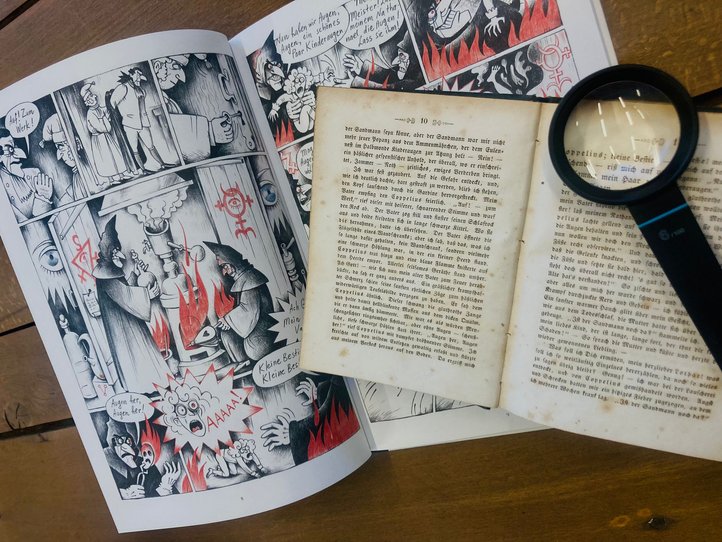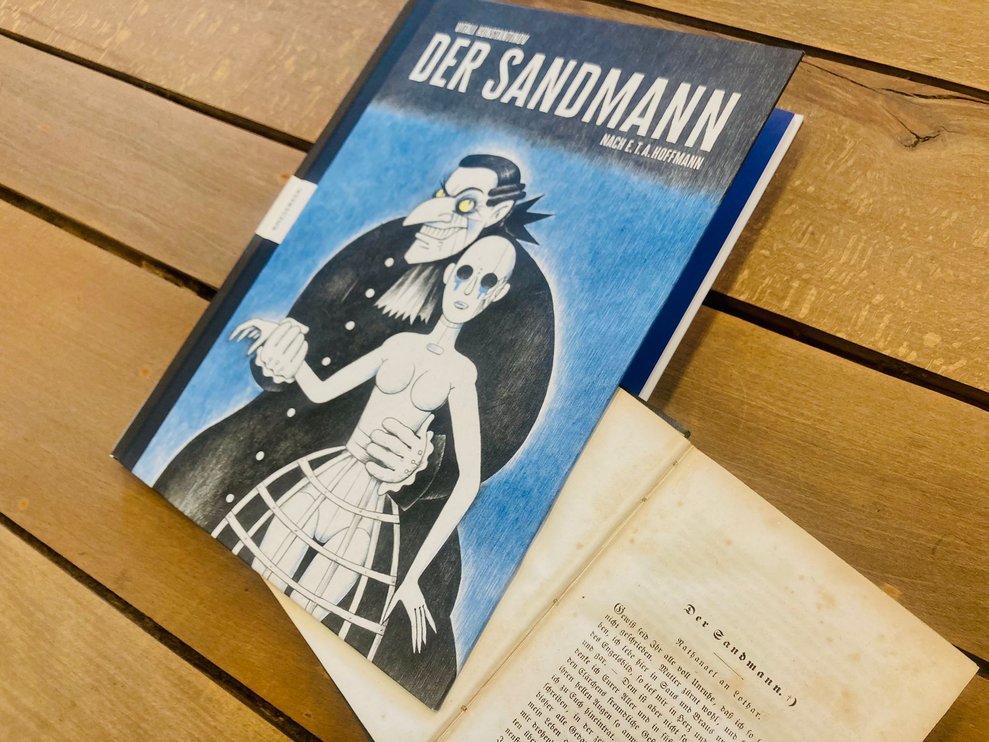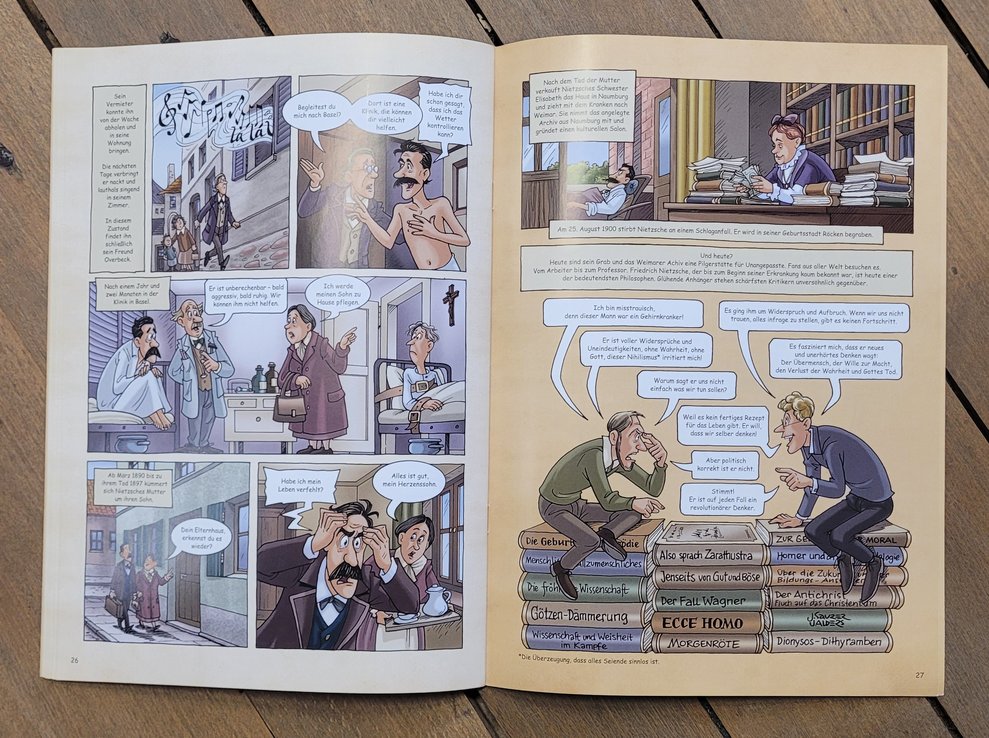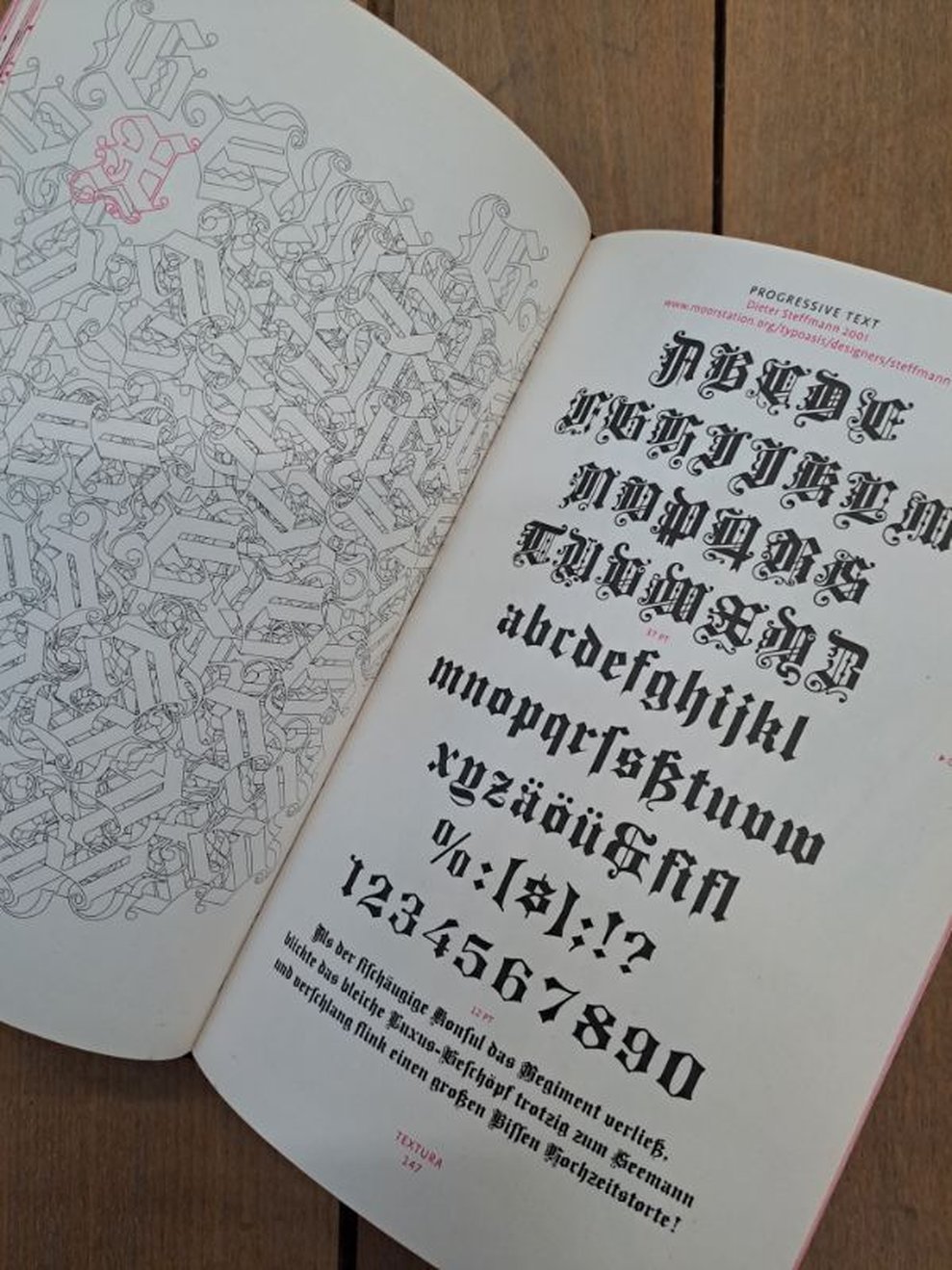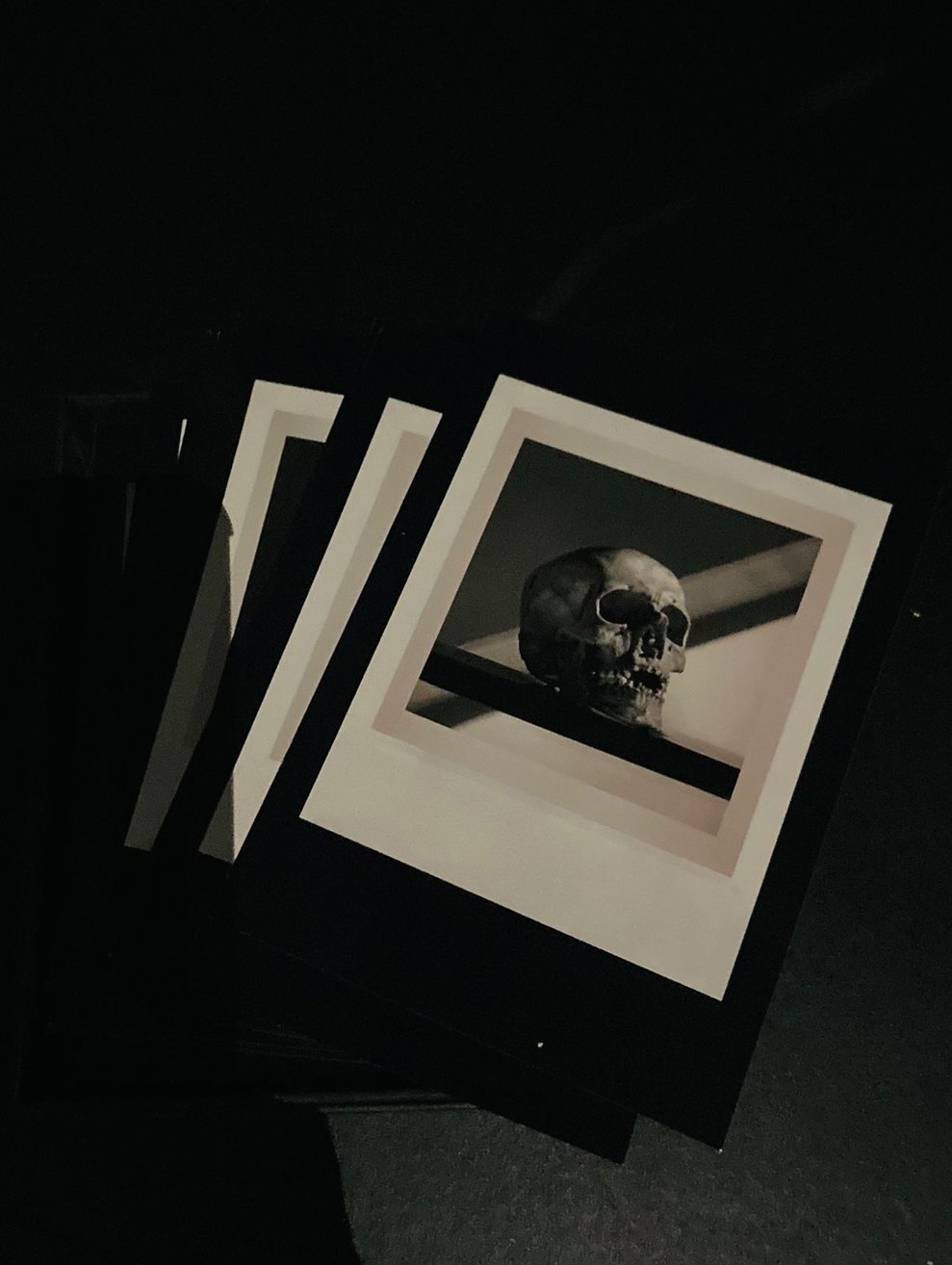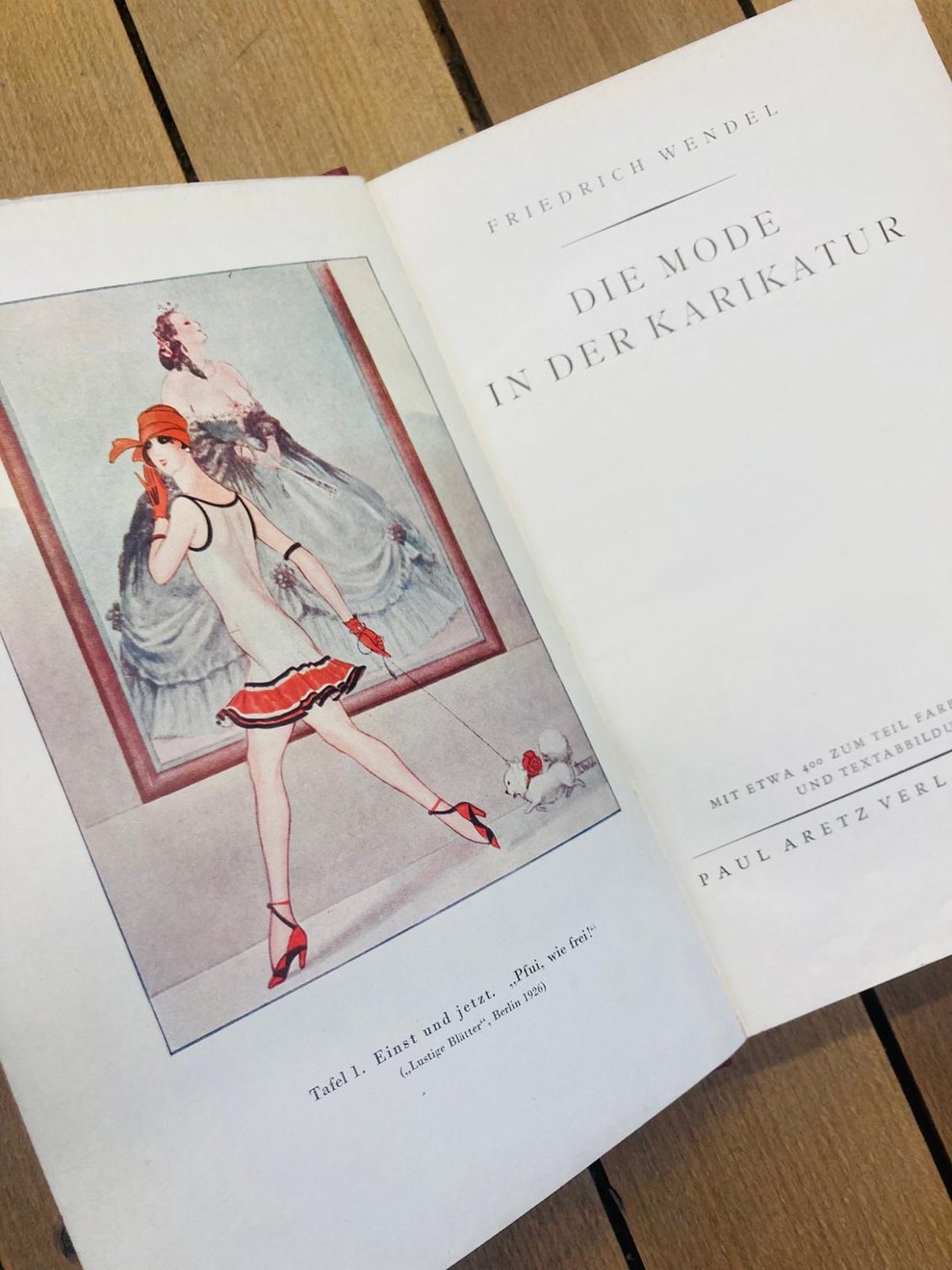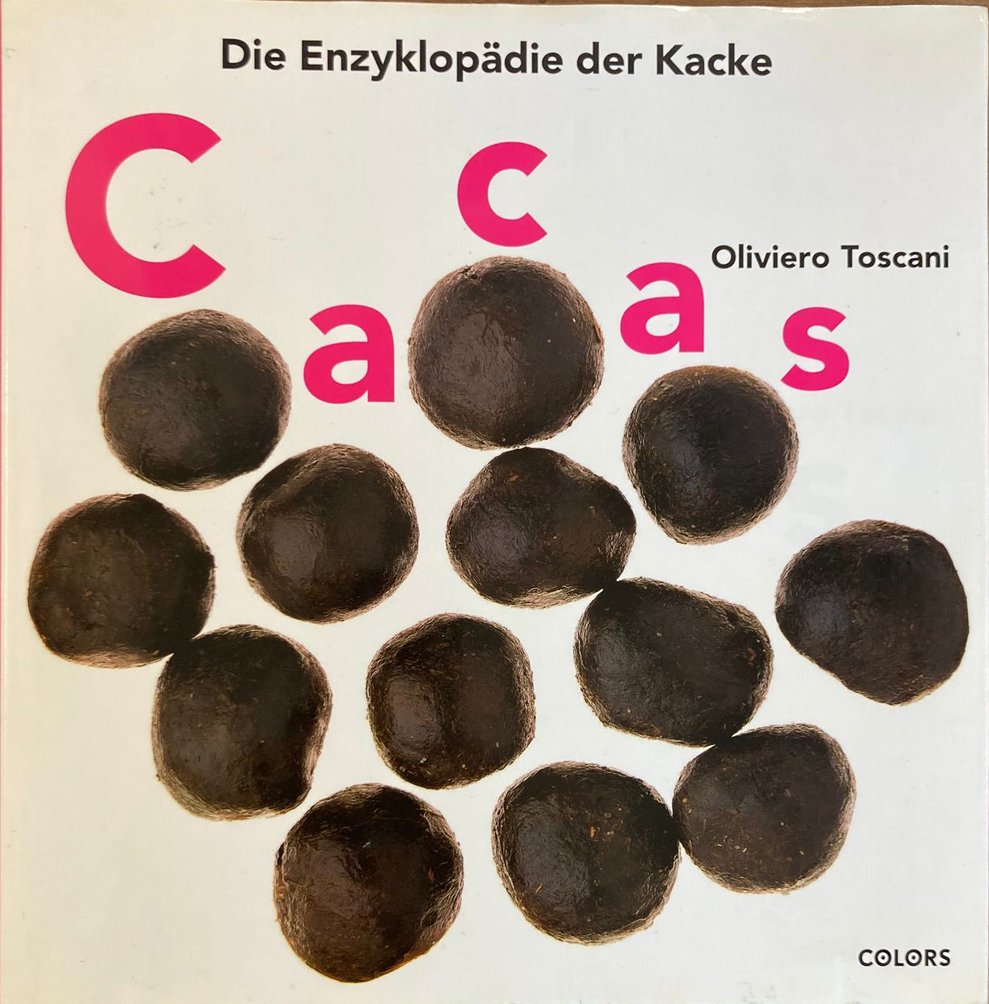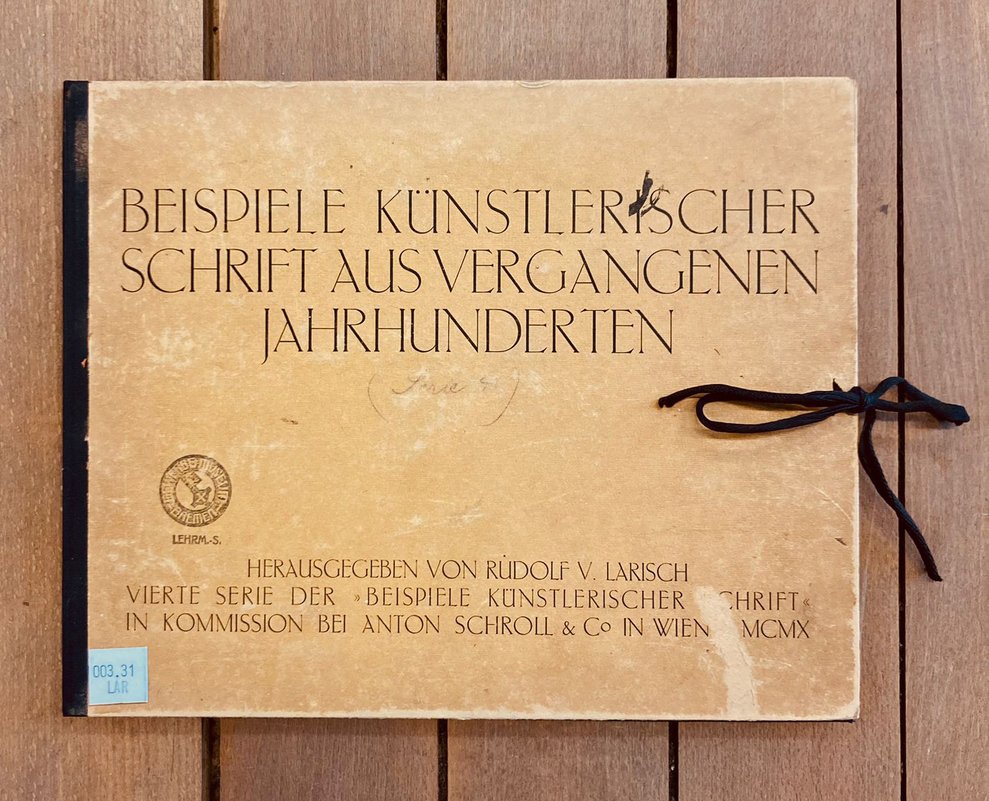Fundstück April 2025
Times are spooky and so is this time's find, which is actually two and yet somehow not. This is because it is both an older book containing a collection of stories still written in Fraktur and a comic about the story “The Sandman” contained in the book. E. T. A. Hofmann, the author of the story, is regarded as something like the Edgar Allan Poe of Germany, but was notorious among his fellow German poets and authors, while Honoré de Balzac and Charles Baudelaire in France celebrated him.
Either way, “The Sandman” is one of Hoffmann's best-known stories and has absolutely nothing to do with the Netflix series “Sandman” (unless the author of the comic book made into a movie took a leaf out of Hoffmann's book when it comes to the creepy factor). Instead, the original story and comic of this find are about all kinds of occult, alchemical, mystical and less mystical things, a lot of toxic masculinity (without the protagonists of the story ever having heard of it) and, above all, the semi-delusions of the main character Nathanael. The story is probably the template for many of today's horror fictions, has plenty of nice literary tricks to offer and is also really creepy and dramatic - and that on just under 50 pages in the original and just under 45 pages in the comic, which was illustrated by Vitali Konstantinov with few colors and suitably exaggerated. Incidentally, it is worth reading the original text first before turning to the comic.
Fundstück Januar 2025
It's the end of the year - some call it Christmassy - and in keeping with this time of year, this month's find is also about a crazy guy with a special beard: Friedrich Nietzsche. In the comic “Friedrich Nietzsche - The Revolutionary Thinker”, the life of the philosopher is briefly and concisely rattled off and he himself is stylized into a kind of little superhero (including a red cape on the cover). Breaking down Nietzsche's life and work into 28 colorful illustrated pages is an impossible task that is only partially unraveled here, but the whole thing is probably more of a joke - which the blurb itself already questions.
For a more serious discussion, it might be better to look further afield in the library, where there are also less colorfully illustrated, thicker books on the same or similar Christmas themes, which you can then - with good intentions - have a good look at in the new year. In Nietzsche's spirit - “God is dead” - I wish you a few nice days off.
Fundstück November 2024
“Fraktur mon Amour” - this find by Judith Schalansky from 2006 deals with the author's great love. But this love is somewhat wicked, because the object of love has a bad reputation: Fraktur.
Yet this typeface bears its bad image partly without justification. Because those who are largely responsible for this bad reputation have simply misused the font, which is of significantly older origin, for their own purposes - as they have done with so many things. The National Socialists later even devalued and defamed Fraktur themselves. Nevertheless, the broken fonts still have a certain stigma attached to them and the book addresses this in short texts, but above all in loving graphic attention and a playful approach to the most beautiful typeface in the world (according to the author).
The whole book is a declaration of love, a homage and an examination at the same time, which brings you a little closer to the ostracized typeface genre, if you didn't already have an affinity for it - like the writer of these lines. He enjoys this attempt at clarification and the joyful play with it, “Fraktur mon Amour” is fun and gives a great impression, that's all you need.
And yet the book also provides a data medium that contains many of the illustrated typefaces for your own type library, so that Fraktur can be reintroduced, even if some of the printed examples should still be used with a critical eye, precisely because the love of Fraktur can be ambivalent. It has my love.
Fundstücke Juli 2024
When searching for a found item in the library, you come across many surprising and less whimsical things. In the rather dark, windowless - so-called closed - stacks behind the office, many items, especially old ones, are stored. When you enter the air-conditioned, somewhat spooky room with its revolving shelves, it's best to greet the stacks' ghosts with a friendly “hello” or an enthusiastic “hello”. This usually works quite well and the ghosts let you do your work in peace. Only rarely do books fall on your head or the shelves roll towards you as if guided by a ghost. However, you do bump your elbow from time to time, but this is probably less due to the ghosts.
Nevertheless, there was a shock with this find when the writers of these words unexpectedly became aware of a skull in the semi-darkness of the archive. Admittedly, it wasn't a huge shock, but it was enough to make us take notice of this beautiful find. It was “Douglas Gordon's The Vanity of Allegory”, an exhibition catalog in the form of a (coverless?) box, published on the occasion of an exhibition of the same name in 2005. The box is filled with 49 postcard-like loose sheets showing works, texts and references to or from the exhibition. The whole thing has something of a cultist construction or typesetting box and encourages a playful approach to the sometimes morbid motifs. Unfortunately, the catalog doesn't seem to be complete, but perhaps the magazine ghosts will release the missing parts at some point - they usually do.
No less spooky is the second find that the magazine ghosts let us get our hands on, although it has almost the same format as the first find (16.7 x 12.2 x 3 centimeters), coincidence? In any case, the book “The Hidden World” is a small archive compiled by the artist Jim Shaw, who, in addition to his actual artistic work, likes to search for unusual, sometimes suspicious finds at markets and in thrift stores and presents them here in this book. This “Didactic Art Collection” brings together covers of Christian magazines from the 1950s, indie comic excerpts, anti-religious flyers, belly excerpts from UFO enthusiasts, patriot magazines, early science fiction covers, private and semi-public photos, tarot advertisements and much more. The compilation seems to want to tell a story, which at the same time eludes us or can be read in fifty+ different ways. This find also has something mysterious and occult about it, and not just because of the cover - something between a Bible and an adventure novel. Shaw resolves the strange narrative entanglement of the pages to some extent at the end by offering a glossary of the things found, but this is not necessary for reading pleasure. Without this knowledge, the absurdity of the content develops much better and makes for morbid fun.
Come back to the library and have a look at these and other finds, be they wondrous or expected. See you soon.
Fundstücke Mai 2024
As this month's finds, we are presenting both an old and a new book. While "Die Mode in der Karikatur" (1928) deals with more or less witty caricatures and commentaries on the fashion world of the 19th and early 20th centuries, the book "Get Rid of Meaning" (2021) is about something completely different, namely the authorship of Kathy Acker, the so-called Queen of Punk. The Badischer Kunstverein exhibition catalog provides insights into the author's amusing and sometimes wild world of research and work, including hemorrhages, giant black spiders, pimples and goddesses eating men.
Two books that have absolutely nothing to do with each other, except perhaps a certain intention of humor and statement, but which could hardly be more different. And only one of them actually matches the humor of the person writing here, which one it is is anyone's guess. 😊
In any case, both can be found in the Kunst am Speicher XI branch library and both are an expression of their time and their humor, which comments on the respective zeitgeist. As I said, sometimes more, sometimes less successful.
The third find that just crept into our hands was the "Alfred-Marie fashion sheets". Admittedly, this may seem a little belated, but this folder with hand-colored woodcut prints from the 10s of the 20th century immediately appealed to us and we couldn't see why it should take a back seat to the other two finds, if anything the other way around. The fragile pencil case is a real eye-catcher and, in addition to its very own illustrations, also features silk endpapers and self-made printing paper - unfortunately, it has probably seen better days.
However, the depths of the library always bring interesting things to light. But see for yourself and drop by the library.
Fundstücke März 2024
The library is known to be a place of peace, contemplation and knowledge. There is a similar situation with another place: the toilet, also known as the privy, another parallel. The library can also satisfy needs by imparting knowledge, inspiration or as a space for learning, being or meeting. And so our radio piece more or less covers several needs at once, in a certain way. Because the book "Cacas - The Encyclopedia of Poop" brings us closer to the world of excrement of the various inhabitants of this earth and gives us a fantastic insight into textures and color aspects. It is certainly also suitable for reading in the loo, but we would not recommend it. Nevertheless, take a look in the library and - to relax - take a look at the book or the diverse collection of the branch library.
Have you always wanted to know what it looks like when mostly old men, edicts, decrees, documents and the like were written in beautiful script and extinct languages on elaborately scooped paper or animal skins? Then this find is just the thing - in "Examples of Artistic Writing from Past Centuries" you will find exactly that in a finely presented loose collection of pages and repros. While the content will usually only be accessible to those familiar with Latin, it is primarily the skillful handwriting and decorative lettering that is effective here, giving an impression of how such documents were designed and set up at the time. Like many such old teaching materials, this find is also in the library's stacks and can be made available to you from there if you are interested in such writings. So why not drop by the library anyway and take a look at the book or the library's diverse collection?
